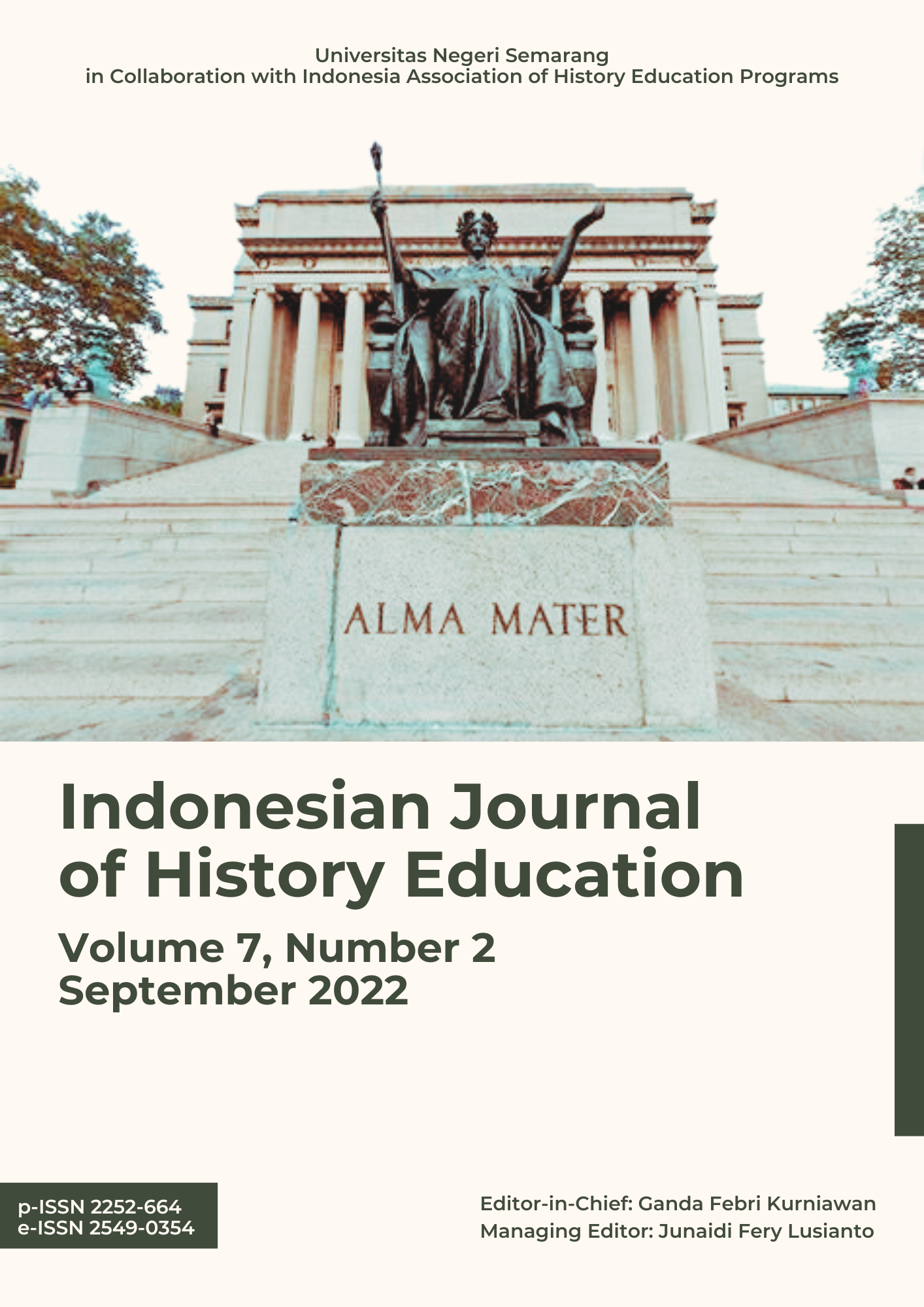Students Understanding of Historical Values Islamic Sharia Organization at SMA Cokroaminoto 1 Banjarnegara
Abstract
The purposes of this research are (1) to analyze student's understanding of the historical values, (2) to analyze student's understanding of the implementation of the historical values, and (3) to analyze student constraints in understanding the historical values of Syarikat Islam organization, at Cokroaminoto 1 High School Banjarnegara. The approach of this research is qualitative with a case study strategy. Data sources include informants, events, and documents. Data collection techniques include observation, in-depth interviews, and document review—validity test of the data using data and methodological triangulation. Data analysis techniques use interactive models. The results showed that 1) students' understanding of the historical values of Syarikat Islam was not optimal. Students do not necessarily understand the historical values of Syarikat Islam even though the school is labeled Syarikat Islam. Students' understanding cannot be generalized into specific categories. 2) The student's understanding of the implementation of the historical values of Syarikat Islam is still lacking. Student implementation arises from understanding, while understanding arises from habituation. 3) Students also encounter considerable obstacles in understanding the historical values of Syarikat Islam from learning, facilities, and history teachers.
References
-----. (2018). Sejarah Syarikat Islam Banjarnegara dan Kontribusinya di Bidang Pendidikan. Semarang: Jurusan Sejarah FIS UNNES.
Amin, S. (2011). Pewarisan Nilai Sejarah Lokal Melalui Pembelajaran Sejarah Jalur Formal dan Informal pada Siswa SMA di Kudus Kulon. Paramita, 21(1),105-115.
Atno. (2011). Efektivitas Media CD Interaktif dan Media VCD terhadap Hasil Belajar Sejarah Siswa SMA Negeri di Banjarnegara Ditinjau dari Tingkat Motivasi Belajar. Paramita, 21(2), 213225.
Basuki. (2005). Dinamika Pendidikan Islam Syarekat Islam di Jawa Tengah. Disertasi. Yogyakarta: Pascasarjana UIN Sunan Kalidjaga.
Burke, P. (2001). Sejarah dan Teori Sosial. Jakarta: Yayasan Obor Indonesia.
Chaerulsyah, E.M. (2014). Persepsi Siswa tentang Keteladanan Pahlawan Nasional untuk Meningkatkan Semangat Kebangsaan. Indonesian Journal of History Education, 3(1), 1-5.
Eha, J. (2012). Pengaruh Pembelajaran Sejarah dengan Peneladanan Biografi Pahlawan terhadap Pengembangan Karakter Siswa: Studi Quasi Eksperimen terhadap Siswa kelas XI IPS di SMA N 8 Bandung. Tesis. Bandung: Universitas Pendidikan Indonesia.
Hasan, S.H. (2012). Pendidikan Sejarah untuk Memperkuat Pendidikan Karakter. Paramita, Historical Studies Journal, 22(1), pp.81–95.
Miles, M.B. dan A.M. Huberman. (1992). Analisis Data Kualitatif: Buku Sumber tentang Metode-Metode Baru. Terjemahan Tjejep Rohendi Rohidi. Jakarta: UI Press.
Moleong, L.J. (2009). Metode Penelitian Kualitatif. Bandung: Rosdakarya.
Ormrod, J.E. (2008). Psikologi Pendidikan: Membantu Siswa Tumbuh dan Berkembang. Diterjemahkan oleh Wahyu Indrianti. Jakarta: Erlangga.
Sodiq, I., A. Suryadi, dan T.A. Ahmad. (2014). Program Guru Menulis: Upaya Peningkatan Kompetensi Profesional Guru Sejarah dalam Penulisan Karya Ilmiah di Kabupaten Semarang. Rekayasa, 12(1), 42-47.
Suardi, E. dan P. Puspa. (2013). Pemanfaatan Monumen Perjuangan Bangsal sebagai Sumber Belajar Sejarah Bagi Generasi Muda di Desa Dalung, Badung. Candra Sankala, 1(1), pp. 1-10.
Susrianto, E. (2012). Peranan Pendidikan Sejarah dalam Membangun Karakter Bangsa. Lentera: Jurnal Ilmu-Ilmu Sejarah, Budaya, dan Sosial, 1(5), pp. 33-44.
Sutopo, H.B. (2006). Metodologi Penelitian Kualitatif Dasar Teori dan Terapannya dalam Penelitian. Surakarta: Universitas Sebelas Maret.
Utomo, C.B., S. Amin, dan T.N. Ria. (2018). Wayang Suluh as A Learning Media in Teaching History in High School. Paramita, 28(1),pp. 105-111.
Yazici, S. And M. Aslan. (2011). Using Heroes as Role Models in Values Education: A Comparison between Social Studies Textbooks and Prospective Teachers’ Choice of Hero or Heroines. Edam, 11(4), pp. 2184-2188.
Yin, R.K. (2008). Studi Kasus: Desain dan Metode. Diterjemahkan M. Djauzi Mudzakir. Jakarta: Raja Grafindo Persada.
Sugiarto, B., & Rofik, A. (2020). Gerakan syarikat Islam kembali ke khittah tahun 1905. Jurnal Politik Profetik, 8(2), 218-239.
Kasim, M. (2016). Organisasi Islam dan Pengarunya Pada Hukum Islam di Indonesia. Jurnal Ilmiah Al-Syir'ah, 7(1).
Toni, H. (2020). Dakwah Syarikat Islam Dan Kontribusinya Dalam Masyarakat Indonesia. Anida (Aktualisasi Nuansa Ilmu Dakwah), 20(2), 221-238.
Hamdani, E. R. (2017). Peran Haji Agus Salim dalam Syarikat Islam 1915-1935 (Doctoral dissertation, UIN Sunan Gunung Djati Bandung).
Subekti, V. S. (2014). Partai Syarikat Islam Indonesia: Konstestasi Politik hingga Konflik Kekuasaan Elite. Yayasan Pustaka Obor Indonesia.
Yunita, M., Sair, A., & Hudaidah, H. (2015). Partai Syarikat Islam Indonesia (PSII) dalam Menghadapi Krisis Malaise di Palembang Tahun 1930-1940 (Sumbangan Materi pada Mata Pelajaran Sejarah Kelas XI SMA Srijaya Negara Palembang). Criksetra: Jurnal Pendidikan Sejarah, 4(2).
Copyright (c) 2022 Indonesian Journal of History Education

This work is licensed under a Creative Commons Attribution 4.0 International License.
Copyright Notice
An author who publishes in the Jurnal Indonesian Journal of History Education agrees to the following terms:
- Author retains the copyright and grants the journal the right of first publication of the work simultaneously licensed under the Creative Commons Attribution-ShareAlike 4.0 License that allows others to share the work with an acknowledgement of the work's authorship and initial publication in this journal
- Author is able to enter into separate, additional contractual arrangements for the non-exclusive distribution of the journal's published version of the work (e.g., post it to an institutional repository or publish it in a book) with the acknowledgement of its initial publication in this journal.
- Author is permitted and encouraged to post his/her work online (e.g., in institutional repositories or on their website) prior to and during the submission process, as it can lead to productive exchanges, as well as earlier and greater citation of the published work (See The Effect of Open Access).
Read more about the Creative Commons Attribution-ShareAlike 4.0 Licence here: https://creativecommons.org/licenses/by-sa/4.0/.




